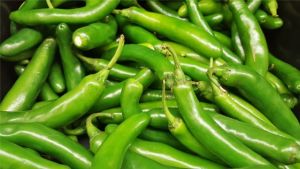What is a Serrano Pepper?
There are different types of peppers that are used to add heat and flavor to cuisine, and one of them is the serrano pepper. In this article, we will discuss what makes it different from other types of peppers and how it is applied in cooking.
General Overview.[edit]
Like all types of chilli peppers, the serrano belongs to the species Capsicum annuum. The serrano pepper originates from Puebla and Hidalgo, which are mountainous states in Mexico. In fact, the serrano’s name is derived from the word “sierra”, which means mountain.
Serrano peppers come in many colors, starting from green. When it ripens, it can come in colors like green, red, orange, yellow and brown. A serrano pepper is ready to harvest even when it is still unripe, as the green peppers are also used in cuisine. A typical serrano pepper is about 1 to 2 inches long, but can pack about 5 times more heat than a jalapeño pepper.
Taste.[edit]
Serrano peppers go from moderate to high heat, depending on one’s tolerance. They range from 10,000 to 23,000 in the Scoville heat scale. Compare this to the popular jalapeño, which ranges 3,500 to 8,000 Scoville heat units. Serranos have milder heat when they are unripe. As they start to ripen, the intensity of heat also increases. In fact, growers are advised to wear gloves when harvesting these peppers as their oil can irritate the skin.
Aside from its strong heat, the serrano pepper also carries a sharp flavor that can stimulate the appetite. One should also watch out for its delayed effect - the heat starts to manifest in the mouth a few moments after the first bite.
Applications in Cuisine.[edit]
Serrano peppers are well-received in salsas, sauces, stews and marinades because they pack a lot of heat. These peppers don’t dry well but are excellent when roasted. Roasting mildens the heat a bit and lends the pepper a bit of sweetness. Serrano peppers can also be minced and eaten raw or as an accompaniment to a dish. They can also be pickled.
Aside from Mexican cuisine, the Serrano pepper is also used in a variety of Thai and Vietnamese dishes. It also adds a kick to alcoholic drinks, especially white liquor like vodka and tequila.
Alternatives.[edit]
While the Serrano pepper is indeed well-received, it can also be hard to find in the local grocer. Jalapeño peppers are easier to find in supermarkets and they possess a similar flavor profile as Serrano peppers, only that they lack in heat. They also have meatier walls so it can affect the texture of a dish.
Cayenne peppers can match the required heat level of Serrano peppers. In fact, as one of the higher members in the Scoville heat scale, it can easily exceed the heat level. While they may be hard to find fresh, only a proportion of your original recipe is needed to substitute for the missing heat.
